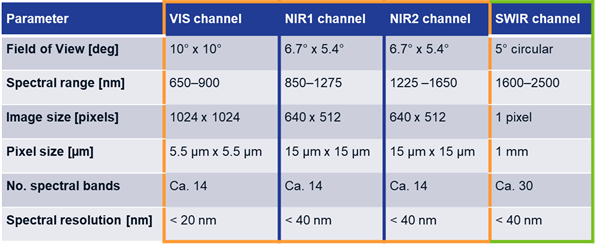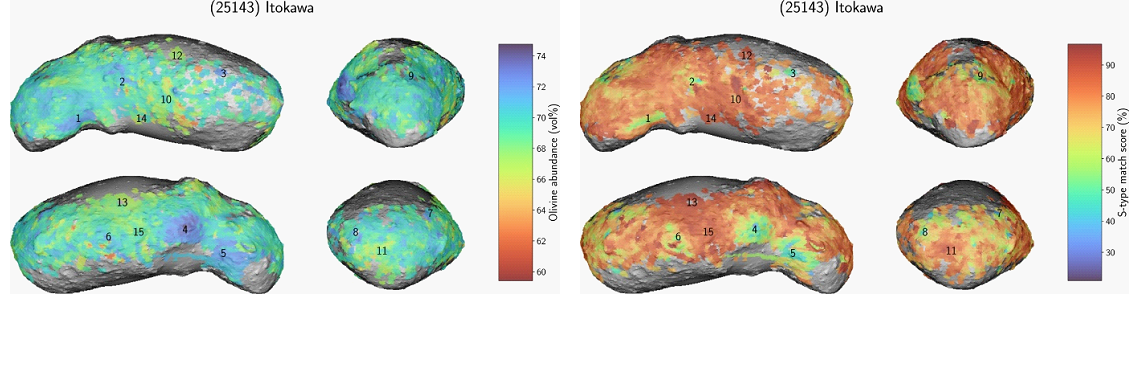- 1University of Helsinki, Faculty of Science, Helsinki University, Finland (tomas.kohout@helsinki.fi)
- 2Institute of Geology of the Czech Academy of Sciences
- 3School of Electrical Engineering, Aalto University, Finland
- 4Astronomical Institute of the Czech Academy of Sciences, Czech Republic
ASPECT is a flexible hyperspectral imager based on tunable Fabry-Perót interference filter (Näsilä and Kohout 2020). It consists of three independent Vis-NIR imaging channels, one single-point SWIR spectrometer, and a dedicated data processing unit (DPU) based on Xiphos Q7 (Table 1). ASPECT is the prime payload of Milani CubeSat carried by ESA Hera mission (Michel et al. 2022, Kohout et al. 2018) to binary asteroid Didymos-Dimorphos and is also considered for RAMSES and Satis missions to asteroid Apophis.
Table 1. ASPECT specifications

Aspect will conduct global hyperspectral mapping of the target asteroids with a resolution of 1 m/px from 5 km. The spectral domain contains key information on surface composition and maturity. Combined with high spatial resolution lateral variations in surface properties can be mapped. To extract such information from ASPECT observations we developed two machine learning convolutional neural network (CNN) codes (Korda et al. 2023ab, 2024) to extract scientific information from ASPECT observations.
The first code quantitatively detects silicate mineral composition (olivine, orthopyroxene, clinopyroxene modal abundances and their Fe, Mg, and Ca content). The second code evaluates space-weathering level based on spectral match score to the spectral type Q (fresh silicate asteroid) or to the type S (space-weathered). The codes were tested on legacy spatially resolved spectra of the asteroid (25143) Itokawa revealing local space-weathering trends in both mineralogy and space weathering indicators (Fig. 1). The apparent correlation between reduction in olivine content with increasing surface maturity is due to higher olivine susceptibility to space weathering-induced damage and related progressive removal of its diagnostic spectral absorption bands relative to these of pyroxenes.

Fig. 1. Local variations in surficial space weathering (left) and olivine content (right) on asteroid Itokawa revealed by the machine learning analysis. Spectral data are obtained by NIRS (Near Infrared Spectrometer) instrument on the Hayabusa (JAXA) spacecraft. The space-weathering level is expressed as a match score to spectral S-type with higher values (redder) being more mature.
The codes will be applied on hyperspectral observations of Didymos-Dimorphos or Apophis asteroids to produce composition and space-weathering maps, detect fresh impact events, map ejecta extent, or to detect local resurfacing. The web interface to access the codes for online user spectra classification can be found here:
https://sirrah.pythonanywhere.com/upload
References:
Michel et al. 2022 DOI 10.3847/PSJ/ac6f52
Näsilä, Kohout 2020 DOI 10.1109/AERO47225.2020.9172437
Kohout et al. 2018 DOI 10.1016/j.asr.2017.07.036
Korda, Kohout 2024, DOI 10.3847/PSJ/ad2685
Korda et al. 2023a DOI 10.1051/0004-6361/202346290
Korda et al. 2023b DOI 10.1051/0004-6361/202243886
How to cite: Kohout, T., Korda, D., Penttilä, A., Rajamäki, L., and Palamakumbure, L.: Detection of composition, space weathering, and local resurfacing using ASPECT hyperspectral imager of ESA Hera / Milani mission, Europlanet Science Congress 2024, Berlin, Germany, 8–13 Sep 2024, EPSC2024-316, https://doi.org/10.5194/epsc2024-316, 2024.